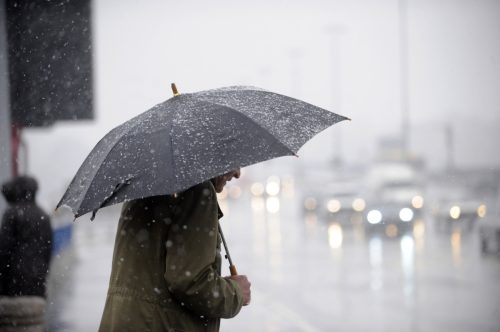Where It’ll Be Extra Warm This Winter, New Weather Predictions Show

Are you dreaming of a white Christmas? Depending on where you’re located in the U.S., you may want to lower your expectations. The National Oceanic and Atmospheric Administration (NOAA), which oversees the National Weather Service (NWS), just released its forecast for the 2023-2024 winter season, and it seems that some parts of the country may be headed for an unusually warm winter. Read on to discover what these new weather predictions show.
RELATED: Here’s When Your Region Will See Its First Frost, According to Weather Experts.
The NOAA just released its winter forecast.

In an Oct. 19 press release, the NOAA announced that federal forecasters from its Climate Prediction Center (which is a division of the NWS) had released their U.S. Winter Outlook for this year. According to the release, for the first time in four years, an El Niño is in place as we head into winter. El Niño is a climate pattern in which “trade winds weaken [and] warm water is pushed back east, toward the west coast of the Americas,” per the NOAA’s website.
“These outlooks provide critical guidance on the upcoming season for many industries and sectors of our economy, from energy producers to commodities markets to agricultural interests to tourism,” NOAA chief scientist Sarah Kapnick, PhD, said in a statement. “With a strengthening El Niño and more potential climate extremes in an already record-breaking year, we’re lucky to have scientists like those at the Climate Prediction Center helping to build a Weather and Climate-Ready Nation by providing critical operational seasonal climate predictions.”
RELATED: What a “Historically Strong” El Niño Could Mean for Your Region This Winter.
They are predicting an extra warm winter for certain areas.

The NOAA says climate patterns like El Niño “break up normal conditions and can affect our weather significantly.” This year, forecasters predict that it’s likely to make for an extra warm winter in some parts of the country. According to their outlook, unusually warm temperatures are expected across the northern tier of the U.S. and a lot of the Far West.
“The greatest odds for warmer-than-average conditions are in Alaska, the Pacific Northwest and northern New England,” the NOAA stated in its release.
Meanwhile, the region extending from the south-central Rockies to the southern Plains is most likely to experience near-normal seasonal mean temperatures, according to the forecast. But some states, including New Mexico, Mississippi, Alabama, Georgia, and Florida, have “equal chances” for below-, near-, or above-average seasonal mean temperatures.
RELATED: 9 Essential Tips to Winter-Proof Your Home.
Some places may also experience more precipitation this winter.

El Niño is not just expected to bring warmer-than-average conditions, however. Due to this climate pattern, the NOAA is also predicting wetter-than-average conditions for northern Alaska, portions of the West, the southern Plains, Southeast, Gulf Coast and lower mid-Atlantic from December through February.
“An enhanced southern jet stream and associated moisture often present during strong El Niño events supports high odds for above-average precipitation for the Gulf Coast, lower Mississippi Valley and Southeast states this winter,” Jon Gottschalck, chief of the Operational Prediction Branch of the Climate Prediction Center, said in a statement.
This could aid “extreme, ongoing drought conditions” that are impacting many parts of the U.S.
“During late October, heavy precipitation is likely to result in drought improvement for the central U.S. El Niño with its enhanced precipitation is expected to provide drought relief to the southern U.S. during the next few months,” Brad Pugh, operational drought lead with NOAA’s Climate Prediction Center, said in a statement.
But other forecasts have different predictions.

The NOAA’s warmer-than-average winter prediction differs from what Farmer’s Almanac indicated in its own recent prediction. Several weeks ago, Farmer’s Almanac released its 2023-2024 extended winter weather forecast, which revealed a significantly snowier season for the U.S. on the whole.
“After a weird and warm winter season last year, this winter should make cold weather fans rejoice—especially those in the Great Lakes, Midwest, and northern New England areas,” editor Pete Geiger said in a statement. “The ‘brrr’ is coming back! We expect more snow and low temperatures nationwide.”
Unlike the NOAA forecast, the Farmer’s Almanac forecast is calling for “below-average temperatures and lots of snowstorms, sleet, ice, [and] rain” for northern New England. But the two organizations agree on one point: “The Southeast and Florida will see a wetter-than-normal winter,” per the Farmer’s Almanac’s release.
RELATED: For more up-to-date information, sign up for our daily newsletter.